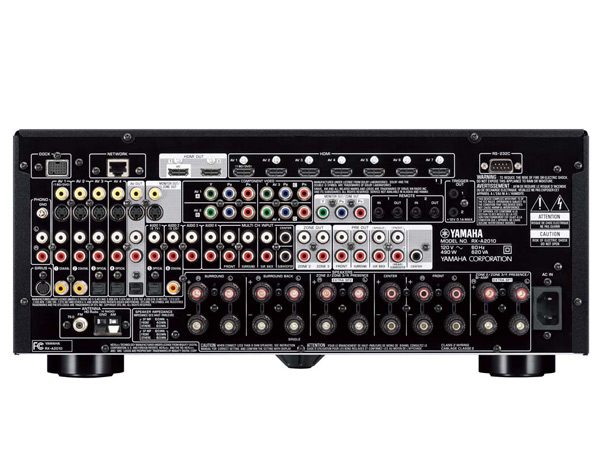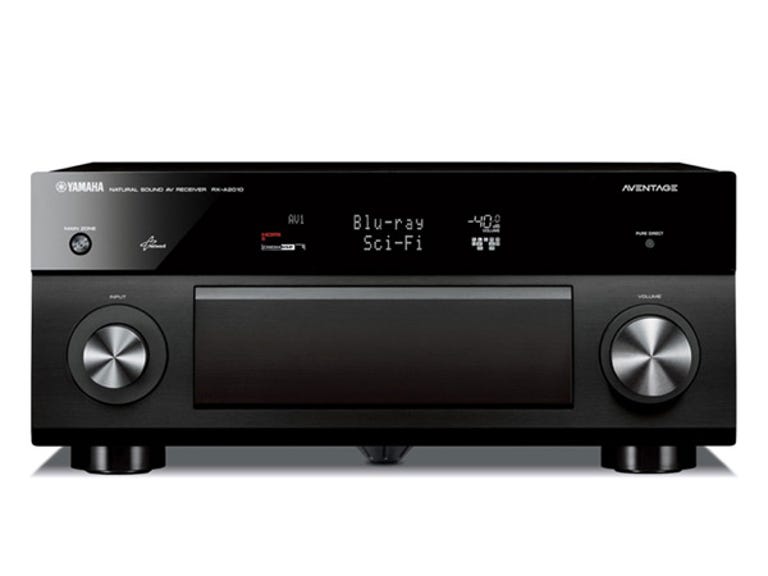 Why You Can Trust CNET
Why You Can Trust CNET Yamaha Aventage RX-A2010 review: Yamaha Aventage RX-A2010
If you want high-quality all-around performance, excellent connectivity, excellent sound and good support for network audio, then the Yamaha Aventage is still right up there.
The Yamaha Aventage RX-A2010 home-theatre receiver is powerful, provides with lots of channels, supports two subwoofer channels and has great video handling. Really, it's difficult to think of any reason not to choose this receiver, aside perhaps from the price tag.
The Good
The Bad
The Bottom Line
Connections
This is a home-theatre receiver in which few compromises have been made with regards to connections. Most companies are dropping S-Video in favour of HDMI. This receiver has seven HDMI inputs on the back panel, plus one on the front for ad-hoc connections, and still has lots of S-Video inputs. Also component video, composite video, analog audio and digital audio. Probably overkill, but if you have a consumer-electronics source device made in the past 20 years, then this receiver will support it (aside from the Euro SCART, which no one supports).

Like connections? Feast your eyes on this panel.
(Credit: Yamaha)
This is a proper 7.2-channel receiver. There are two subwoofer outputs, and these can be set to have the same signal, or separate ones (either left and right, or front and rear).
The two HDMI outputs support 3D content, plus one of them supports the Audio Return Channel.
Set-up
The auto-calibration wizard guides through the set-up process within a couple of minutes, using the supplied microphone. You have a choice between a single-position measurement, or multiple positions. The unit also applies EQ, but you can switch this off if you prefer.
On the fairly conventional speaker package I used, the system applied sensible settings, including correctly choosing "Small" for the centre channel.
You get lots of options for a second zone (and a third one), including video support. In addition to the bulky main remote control, you get a neat little compact one. This actually permits just about as much control as the main remote, albeit via the menus.
Sound
This receiver has not seven, but nine channels of amplification. Each of those has 140 watts of real hi-fi continuous power into eight ohms (two channels running at a time). It's going to be a very difficult speaker system that will give this receiver problems. If it does, preamplifier outputs for all channels allow you to use external power amplifiers.
Yamaha receivers don't support Dolby Pro Logic IIz, which processes sound to extract two front "height" channels. But it comes with a great variety of Yamaha's own DSP modes, some of which generate "Presence" channels, which are much the same thing. So, a full-blown system will have two stereo speakers, a centre channel, two front height speakers, two surround speakers and two rear-surround speakers. Of course, you don't have to connect up all nine channels; there is a lot of flexibility to use some of the channels to drive other zones (eg, stereo in two zones in addition to the main listening room), or to be used for other purposes.
The default set-up had the unit producing top-class sound in surround mode. The receiver has a silly default setting for stereo audio inputs: nine-channel stereo. This sends the music to all of your loudspeakers, which is not the way to listen. Change it to "Stereo" or "Straight".
Video
By default, the receiver converts analog video into HDMI format, but leaves the video from HDMI inputs unprocessed. Even in this state, though, it has the ability to overlay its menus on top of whatever video programming is passing through the unit. This extends even to 3D content, which is a rare feature. In 3D mode, the menus look like they're hovering in front of the program material.
The video processing itself — HQV — worked very well. It turned our 576i and 1080i test signals into very good quality 1080p with good clarity, correctly detecting their underlying film/video status, and applying the appropriate processes for good results.
iPod etc
Your iPod/iPhone has a wealth of support with this receiver. For one thing, it comes with a neat-looking iPod dock that plugs into a proprietary port at the back. This supports video, as well as sound. Alternatively, you can plug your device into the front USB with a standard iPod cable, and get sound, but not video. You can get Yamaha's wireless iPod dock, which works rather like a Bluetooth function, except that it uses a proprietary Yamaha wireless format.
What you can't do is use Apple AirPlay, unlike some of the competition. But, as of December, that doesn't matter, because Yamaha's "A/V Controller" app has been updated to provide similar music push functionality (it also delivers cover art, just like AirPlay). This is better than AirPlay in two ways: firstly, you can use the app to control other aspects of performance (eg, change the surround mode) without interrupting play; and secondly, there's an Android version available as well, so it isn't Apple only. However, unlike AirPlay, the iOS version at least wouldn't multitask.
If we want to be really picky, we would say that the volume control should allow you to drag the slider, rather than having to stab the + and - dots on the screen.
You can plug USB devices into the front socket. The unit supports MP3 and WMA, of course, plus WAV and FLAC for lossless quality. Importantly, it has good acceleration options for navigating through long lists.
You get the ubiquitous DLNA support, and for internet radio vTuner is provided. The implementation on both is good, with fast communications and list displays, and the same good list navigation features as with USB content.
Overall
Hey, if dollars per kilogram is your measure of value for home-theatre receivers, then at nearly 18kg, the Yamaha Aventage RX-A2010 is right up there. If you want high-quality all-around performance, excellent connectivity, excellent sound and good support for network audio, then this one is still right up there.


